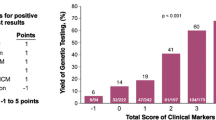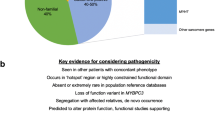Abstract
Hypertrophic cardiomyopathy (HCM) is considered to be a genetic disease. As such, multidisciplinary approach is needed to evaluate and treat this condition. We present several patient vignettes to illustrate the complementary skills of cardiologists and genetic counselors in providing comprehensive care. Translational application of research will continue to expand as more genetic causes of HCM will be recognized and more genetic tests will become available. Now is the opportunity to build a strong collaboration between the two disciplines to be prepared for the era of personalized medicine.
Similar content being viewed by others
References
Braunwald, E., Morrow, A. G., Cornell, W. P., et al. (1960). Idiopathic hypertrophic subaortic stenosis: clinical, hemodynamic and angiographic manifestations. Am J Med, 29, 924–945.
Bos Martijn, J., Towbin, J. A., & Ackerman, M. J. (2009). Diagnostic, prognostic, and therapeutic indication of genetic testing for hypertrophic cardiomyopathy. JACC, 54, 201–211.
Fellgiebel, A., Muller, M. J., & Ginsberg, L. (2006). CNS manifestations of Fabry’s disease. The Lancet Neurology, 5, 791–796.
Frenneaux Michael, P. (2004). Assessing the risk of sudden cardiac death in a patient with hypertrophic cardiomyopathy. Heart, 90, 570–575.
Hendriks Karin, S. W. H., Hendriks, M. M. W. B., Birnie, E., et al. (2008). Familial disease with a risk of sudden death: a longitudinal study of the psychological consequences of predictive testing for long QT syndrome. Heart Rhythm, 5(5), 719–724.
Hershberger Ray, E., Lindenfeld, J., Mestroni, L., Seidman, C. E., Taylor, M. R. G., & Towbin, J. A. (2009). Genetic evaluation of cardiomyopathy—a Heart Failure Society of America practice guideline. J of Cardiac Failure, 15(2), 83–97.
Ingles, J., Doolan, A., Chiu, C., Seidman, J., Seidman, C., & Semsarian, C. (2005). Compound and double mutations in patients with hypertrophic cardiomyopathy: implication for genetic testing and counseling. J Med Genetics, 42, e59.
Kampmann, C., Baehner, F., Whybra, C., Martin, C., Wiethoff, C. M., Ries, M., et al. (2002). Cardiac manifestations of Anderson–Fabry disease in heterozygous females. J Am Coll Cardilogy, 40, 1668–1674.
Kofflard Marcel, J. M., Folkert, J. T., van der Lee, C., & van Domburg, R. T. (2003). Hypertrophic cardiomyopathy in a large community based population: clinical outcome and identification of risk factors for sudden cardiac death and clinical deterioration. J Am Coll Cardiology, 41(6), 987–993.
Maron Barry, J., Seidman, J. G., & Seidman, C. E. (2004). Proposal for contemporary screening strategies in families with hypertrophic cardiomyopathy. J Am Coll Cardiology, 44, 2125–2132.
Mehta Atul and Hughes DA, Fabry Disease, GeneReviews (updated 2008) www.genetests.org
Morita, Hiroyuki, Rehm, H. L., Menesses, A., et al. (2008). Shared genetic causes of cardiac hypertrophy in children and adults. NEJM, 358(18), 1899–1908.
Robertson PJ, Kay GN, Warnock, DG, Jackson l, Tallaj J (2009) Arrhythmias and Implantable cardioverter defibrillators in Fabry cardiomyopathy, The Journal of Heart and Lung Transplantation 28 (2) Supplement, abstract # 94
Sorajja, P., Elliott, P. M., & McKenna, W. J. (2000). The molecular genetics of hypertrophic cardiomyopathy: prognostic implications. Europace, 2, 4–14.
Van Driest Sara, L., Vasile, V. C., Ommen, S. R., Will, M. L., Tajik, A. J., Gersh, B. J., et al. (2004). Myosin binding protein C mutations and compound heterozygosity in hypertrophic cardiomyopathy. J Am Coll Cardiology, 44(9), 1903–1190.
Wang Raymond, Y., Lelis, A., Mirocha, J., & Wilcox, W. R. (2007). Heterozygous Fabry women are not just carriers, but have a significant burden of disease and impaired quality of life. Genet Medicine, 9(1), 34–45.
Zarate Yuri, A., & Hopkin, R. J. (2008). Fabry’s disease. The Lancet, 372, 1427–1435.
Author information
Authors and Affiliations
Corresponding author
Rights and permissions
About this article
Cite this article
Skrzynia, C., Demo, E.M. & Baxter, S.M. Genetic Counseling and Testing for Hypertrophic Cardiomyopathy: An Adult Perspective. J. of Cardiovasc. Trans. Res. 2, 493–499 (2009). https://doi.org/10.1007/s12265-009-9127-4
Received:
Accepted:
Published:
Issue Date:
DOI: https://doi.org/10.1007/s12265-009-9127-4




